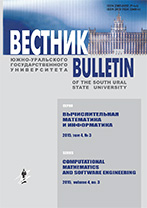|
Neural network approach for mapping of parallel applications
N. N. Popova, M. V. Kozlov, M. V. Shubin
Lomonosov Moscow State Universisty (GSP-1, Leninskie Gory 1, Moscow, 119991 Russia)
Abstract:
The article is about the problem of improving parallel applications efficiency. It proposes an approach to solve this problem. The approach aims to reduce communication overheads of data exchange between parallel program processes during its execution on high-performance computing system. Growing number of computer nodes leads increasing impact of the communication overhead on application performance. As a sequence the problem of parallel processes allocation to hardware nodes (mapping problem) becomes very actual. The new approach for mapping problem is proposed in this work. The key characteristic of the approach is to extract a communication pattern by phase analysis of application using a convolutional neural network to fast choosing the most relevant mapping algorithm for extracted pattern. Investigation of results of point-to-point communications between parallel program processes is used to build a communication pattern. The application timeline is broken into equal intervals. Communication patterns are created for each interval. Then Haar 2D wavelet transform is applied to these patterns for generating features. Features are clustered, after that, timeline is splitted into phases. Each phase has its own communication pattern. The selection of the most relevant mapping algorithm is performed by using convolutional neural network. It supposes some knowledge about different types of parallel applications and most suitable mapping algorithms. This knowledge must be represented by a set of pattern classes (classes of matrices), each class has the mapping algorithm, which fits best for application with this type of pattern. This set can be a training sample for the neural network. Thus the neural network classifies an input application communication pattern and finds a mapping algorithm for the application. The stages of proposed approach are implemented in this work. This implementation is demonstrated for some tests.
Keywords:
high performance computing systems, topology-aware mapping, communication pattern, convolution neural network.
Received: 12.11.2019
Citation:
N. N. Popova, M. V. Kozlov, M. V. Shubin, “Neural network approach for mapping of parallel applications”, Vestn. YuUrGU. Ser. Vych. Matem. Inform., 9:1 (2020), 36–49
Linking options:
https://www.mathnet.ru/eng/vyurv230 https://www.mathnet.ru/eng/vyurv/v9/i1/p36
|

| Statistics & downloads: |
| Abstract page: | 106 | | Full-text PDF : | 36 | | References: | 24 |
|




 Contact us:
Contact us: Terms of Use
Terms of Use
 Registration to the website
Registration to the website Logotypes
Logotypes








 Citation in format
Citation in format 